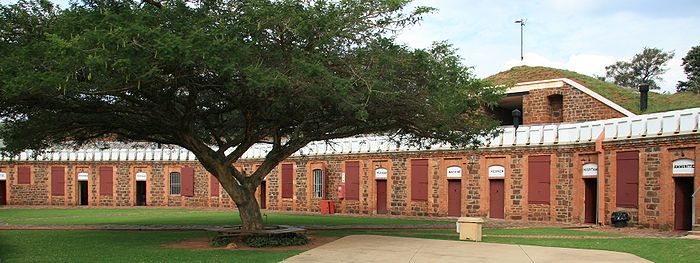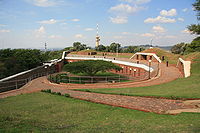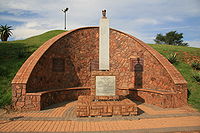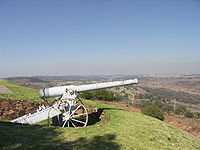
Pretoria Forts
Encyclopedia
The Pretoria Forts consisted mainly of four forts built by the government of the South African Republic
(ZAR) just before the outbreak of the Second Anglo-Boer War around Pretoria
.
After the abortive Jameson Raid
, the government of the ZAR became concerned about the safety of its capital city, Pretoria, both from foreign invasion as well as from the growing number of Uitlanders (Foreigners) on the Witwatersrand
.
Consequently, a defence plan for Pretoria was drawn up by a former French
artillery
officer, Leon Grunberg. This plan was approved on 24 March 1896 by the Executive Council of the ZAR.
The plan recommended that eight strategic positions around the city should be fortified by means of armoured turret
s equipped with artillery. The positions identified were Schanskop, Kwaggaspoort, Daspoortrand, Magaliesberg-wes, Wonderboompoort, Derdepoort, Strubenkop and Klapperkop. The armoured turrets were subsequently found to be unacceptable, and thus the plan of two German
engineer
s, Otto Albert Adolph von Dewitz and Heinrich C Werner to build forts instead, were accepted. However, due to a lack of money, only four forts were eventually built:
The three forts are pentagonal reinforced, with more fire range possibilities through numerous facets. Attacks from any direction could be warded off by revolving guns on their ramparts. To prevent infantry attacks, loopholes were built into the walls. Trenches, barbed-wire entanglements and fortified rooms were erected as reinforcements.
These forts were the most modern structures of their time and modern mediums of communication, such as telephones, were used to equip the telegraph room.
Many black labourers and about 400 white builders, mostly Italians, were involved in the building of these forts. To address technical aspects such as the electrical connections between forts, German and Dutch experts were consulted.




This fort was built at a cost of GBP £47,500. It was handed over to the government on 6 April 1897. It was supplied with a paraffin engine powered generator for electricity, electrical lighting and a search light. A telephone and telegraphic links were also installed. Water was supplied from a pump station in the Fountains Valley which was shared with the nearby Fort Klapperkop.
The garrison was initially armed with one officer and 30 men and was armed with 37 mm Maxim-Nordenfeldt cannon
, Martini-Henry
hand-cranked Maxim machine guns and a 155 mm Creusot gun
(also known colloquially as a "Long Tom")
. By October 1899, only 17 men were still stationed at the fort.
Both the garrison and the armaments were gradually reduced during the course of the Second Anglo-Boer war until there was only one man and no guns left over on 5 June 1900, the day on which British forces occupied Pretoria.
The surrounding area currently includes a refurbished statue of Danie Theron which was originally erected at the Danie Theron Combat School in Kimberley
. The statue was moved to its current location at Fort Schanskop and unveiled on 6 March 2002.
Also included on the premises is a scale model replica of the Trek Monument that was inaugurated on 16 December 1954 in Tanzania
(Formerly known as Tanganyika
).
Fort Schanskop is a Gauteng Provincial Heritage Site and a South African National monument.
This fort was completed in September 1897 by Von Dewitz and Werner for a total cost of GBP £49,000. As with Fort Schanskop, it was also supplied with electricity, a telephone and running water.
The fort was armed with a 75 mm Creusot gun ("Long Tom"), a 37 mm Maxim-Nordenfeldt cannon and a hand-cranked Martin-Henry Maxim. Initially eighteen gunners were stationed in the fort, but both men and armaments were gradually withdrawn until only one gunner and no cannons were left on 5 June 1900.




This fort was constructed at a total cost of GBP £50,000. It was handed over to the Government on 18 January 1898. It was supplied with a paraffin engine powered generator for electricity, a telephone and telegraphic links. Running water was supplied from a pump station in the Fountains Valley which was shared with the nearby Fort Schanskop.
Unlike the other forts in the surrounding area, the design incorporated a moat as well as a drawbridge. The moat was never filled with water.
Fort Klapperkop was armed with a 155mm Creusot gun
("Long Tom")
, a 37 mm Maxim-Nordenfeldt cannon
, three Martini-Henry hand-maxims and a 65 mm Krupp Mountain Gun.
In January 1899 The fort was manned by 17 troops. In July 1899 the number of troops was increased to 30. By end October 1899, only 16 troops were still stationed at Fort Klapperkop. As with the other forts, men and armament were gradually withdrawn and sent elsewhere during the course of the war.
It is said: "Never a shot in anger was fired from this fort."
The area is declared a military museum. On May 31 1979 the South African Defence Force Memorial was unveiled at Fort Klapperkop. It includes a statue of a soldier holding a R1 rifle, in memory of all members of the South African Defence Force who lost their lives serving their country. The individuals who have lost their lives are honored with an inscription on a number of marble plaques mounted around the statue.
Fort Klapperkop is a Gauteng Provincial Heritage Site and a South African National monument.
Fort Daspoortrand was initially manned by twenty-five gunners and was armed with a 155mm Creusot gun
("Long Tom")
and two 37 mm Maxim-Nordenfeldt cannons. As with the other forts, only one soldier and no guns were in the fort on 5 June 1900.
Both Fort Klapperkop and Fort Schanskop were fired upon on 3 June 1900 by British artillery, but the fire wasn't returned and Pretoria was occupied without resistance on 5 June 1900. The forts thus never fulfilled their intended role in the defence of Pretoria. The British forces subsequently armed and manned the forts. Other smaller fortifications were also erected by them in order to strengthen Pretoria's defences.
. Fort Klapperkop was restored in 1966 and converted to a military museum
and Fort Schanskop followed in 1978.
Initially there were plans to convert Fort Wonderboompoort and Fort Daspoortrand into prisons but these were never carried out. The roofs of both forts were later demolished; it was speculated that General
Jan Smuts
gave the orders for this during World War II
, but this has never been proven.
The ownership of Fort Wonderboompoort was transferred to the City Council of Pretoria in 1954. In 1986 it was cleaned up and partially restored; it was declared a National Monument the following year. A request to declare Fort Daspoortrand a National Monument as well was submitted in 1988 but this has not been approved as yet.
South African Republic
The South African Republic , often informally known as the Transvaal Republic, was an independent Boer-ruled country in Southern Africa during the second half of the 19th century. Not to be confused with the present-day Republic of South Africa, it occupied the area later known as the South African...
(ZAR) just before the outbreak of the Second Anglo-Boer War around Pretoria
Pretoria
Pretoria is a city located in the northern part of Gauteng Province, South Africa. It is one of the country's three capital cities, serving as the executive and de facto national capital; the others are Cape Town, the legislative capital, and Bloemfontein, the judicial capital.Pretoria is...
.
After the abortive Jameson Raid
Jameson Raid
The Jameson Raid was a botched raid on Paul Kruger's Transvaal Republic carried out by a British colonial statesman Leander Starr Jameson and his Rhodesian and Bechuanaland policemen over the New Year weekend of 1895–96...
, the government of the ZAR became concerned about the safety of its capital city, Pretoria, both from foreign invasion as well as from the growing number of Uitlanders (Foreigners) on the Witwatersrand
Witwatersrand
The Witwatersrand is a low, sedimentary range of hills, at an elevation of 1700–1800 metres above sea-level, which runs in an east-west direction through Gauteng in South Africa. The word in Afrikaans means "the ridge of white waters". Geologically it is complex, but the principal formations...
.
Consequently, a defence plan for Pretoria was drawn up by a former French
France
The French Republic , The French Republic , The French Republic , (commonly known as France , is a unitary semi-presidential republic in Western Europe with several overseas territories and islands located on other continents and in the Indian, Pacific, and Atlantic oceans. Metropolitan France...
artillery
Artillery
Originally applied to any group of infantry primarily armed with projectile weapons, artillery has over time become limited in meaning to refer only to those engines of war that operate by projection of munitions far beyond the range of effect of personal weapons...
officer, Leon Grunberg. This plan was approved on 24 March 1896 by the Executive Council of the ZAR.
The plan recommended that eight strategic positions around the city should be fortified by means of armoured turret
Turret
In architecture, a turret is a small tower that projects vertically from the wall of a building such as a medieval castle. Turrets were used to provide a projecting defensive position allowing covering fire to the adjacent wall in the days of military fortification...
s equipped with artillery. The positions identified were Schanskop, Kwaggaspoort, Daspoortrand, Magaliesberg-wes, Wonderboompoort, Derdepoort, Strubenkop and Klapperkop. The armoured turrets were subsequently found to be unacceptable, and thus the plan of two German
Germany
Germany , officially the Federal Republic of Germany , is a federal parliamentary republic in Europe. The country consists of 16 states while the capital and largest city is Berlin. Germany covers an area of 357,021 km2 and has a largely temperate seasonal climate...
engineer
Engineer
An engineer is a professional practitioner of engineering, concerned with applying scientific knowledge, mathematics and ingenuity to develop solutions for technical problems. Engineers design materials, structures, machines and systems while considering the limitations imposed by practicality,...
s, Otto Albert Adolph von Dewitz and Heinrich C Werner to build forts instead, were accepted. However, due to a lack of money, only four forts were eventually built:
The Three German Forts
Fort Schanskop, Fort Wonderboompoort and Fort Klapperkop were designed by Von Dewitz and Werner of the German engineering company Krupp, assisted by architect Christiaan Kuntz and building contractor Celso Giri.The three forts are pentagonal reinforced, with more fire range possibilities through numerous facets. Attacks from any direction could be warded off by revolving guns on their ramparts. To prevent infantry attacks, loopholes were built into the walls. Trenches, barbed-wire entanglements and fortified rooms were erected as reinforcements.
These forts were the most modern structures of their time and modern mediums of communication, such as telephones, were used to equip the telegraph room.
Many black labourers and about 400 white builders, mostly Italians, were involved in the building of these forts. To address technical aspects such as the electrical connections between forts, German and Dutch experts were consulted.
Fort Schanskop
25.7775°N 28.185 °W



This fort was built at a cost of GBP £47,500. It was handed over to the government on 6 April 1897. It was supplied with a paraffin engine powered generator for electricity, electrical lighting and a search light. A telephone and telegraphic links were also installed. Water was supplied from a pump station in the Fountains Valley which was shared with the nearby Fort Klapperkop.
The garrison was initially armed with one officer and 30 men and was armed with 37 mm Maxim-Nordenfeldt cannon
Maxim gun
The Maxim gun was the first self-powered machine gun, invented by the American-born British inventor Sir Hiram Maxim in 1884. It has been called "the weapon most associated with [British] imperial conquest".-Functionality:...
, Martini-Henry
Martini-Henry
The Martini-Henry was a breech-loading single-shot lever-actuated rifle adopted by the British, combining an action worked on by Friedrich von Martini , with the rifled barrel designed by Scotsman Alexander Henry...
hand-cranked Maxim machine guns and a 155 mm Creusot gun
155 mm Creusot Long Tom
The 155 mm Creusot Long Tom was a French field gun manufactured by Schneider et Cie in Le Creusot, France and used by the Boers in the Second Boer War.-Second Boer War:...
(also known colloquially as a "Long Tom")
155 mm Creusot Long Tom
The 155 mm Creusot Long Tom was a French field gun manufactured by Schneider et Cie in Le Creusot, France and used by the Boers in the Second Boer War.-Second Boer War:...
. By October 1899, only 17 men were still stationed at the fort.
Both the garrison and the armaments were gradually reduced during the course of the Second Anglo-Boer war until there was only one man and no guns left over on 5 June 1900, the day on which British forces occupied Pretoria.
The surrounding area currently includes a refurbished statue of Danie Theron which was originally erected at the Danie Theron Combat School in Kimberley
Kimberley, Northern Cape
Kimberley is a city in South Africa, and the capital of the Northern Cape. It is located near the confluence of the Vaal and Orange Rivers. The town has considerable historical significance due its diamond mining past and siege during the Second Boer War...
. The statue was moved to its current location at Fort Schanskop and unveiled on 6 March 2002.
Also included on the premises is a scale model replica of the Trek Monument that was inaugurated on 16 December 1954 in Tanzania
Tanzania
The United Republic of Tanzania is a country in East Africa bordered by Kenya and Uganda to the north, Rwanda, Burundi, and the Democratic Republic of the Congo to the west, and Zambia, Malawi, and Mozambique to the south. The country's eastern borders lie on the Indian Ocean.Tanzania is a state...
(Formerly known as Tanganyika
Tanganyika
Tanganyika , later formally the Republic of Tanganyika, was a sovereign state in East Africa from 1961 to 1964. It was situated between the Indian Ocean and the African Great Lakes of Lake Victoria, Lake Malawi and Lake Tanganyika...
).
Fort Schanskop is a Gauteng Provincial Heritage Site and a South African National monument.
Fort Wonderboompoort
25.69233°N 28.19423 °WThis fort was completed in September 1897 by Von Dewitz and Werner for a total cost of GBP £49,000. As with Fort Schanskop, it was also supplied with electricity, a telephone and running water.
The fort was armed with a 75 mm Creusot gun ("Long Tom"), a 37 mm Maxim-Nordenfeldt cannon and a hand-cranked Martin-Henry Maxim. Initially eighteen gunners were stationed in the fort, but both men and armaments were gradually withdrawn until only one gunner and no cannons were left on 5 June 1900.
Fort Klapperkop
25.78019°N 28.21011 °W



This fort was constructed at a total cost of GBP £50,000. It was handed over to the Government on 18 January 1898. It was supplied with a paraffin engine powered generator for electricity, a telephone and telegraphic links. Running water was supplied from a pump station in the Fountains Valley which was shared with the nearby Fort Schanskop.
Unlike the other forts in the surrounding area, the design incorporated a moat as well as a drawbridge. The moat was never filled with water.
Fort Klapperkop was armed with a 155mm Creusot gun
155 mm Creusot Long Tom
The 155 mm Creusot Long Tom was a French field gun manufactured by Schneider et Cie in Le Creusot, France and used by the Boers in the Second Boer War.-Second Boer War:...
("Long Tom")
155 mm Creusot Long Tom
The 155 mm Creusot Long Tom was a French field gun manufactured by Schneider et Cie in Le Creusot, France and used by the Boers in the Second Boer War.-Second Boer War:...
, a 37 mm Maxim-Nordenfeldt cannon
Maxim gun
The Maxim gun was the first self-powered machine gun, invented by the American-born British inventor Sir Hiram Maxim in 1884. It has been called "the weapon most associated with [British] imperial conquest".-Functionality:...
, three Martini-Henry hand-maxims and a 65 mm Krupp Mountain Gun.
In January 1899 The fort was manned by 17 troops. In July 1899 the number of troops was increased to 30. By end October 1899, only 16 troops were still stationed at Fort Klapperkop. As with the other forts, men and armament were gradually withdrawn and sent elsewhere during the course of the war.
It is said: "Never a shot in anger was fired from this fort."
The area is declared a military museum. On May 31 1979 the South African Defence Force Memorial was unveiled at Fort Klapperkop. It includes a statue of a soldier holding a R1 rifle, in memory of all members of the South African Defence Force who lost their lives serving their country. The individuals who have lost their lives are honored with an inscription on a number of marble plaques mounted around the statue.
Fort Klapperkop is a Gauteng Provincial Heritage Site and a South African National monument.
Fort Daspoortrand
Unlike the other forts, Fort Daspoortrand was built by Leon Grunberg and Sam Leon. It thus differed from the other forts, being hexagonal instead of pentagonal and also markedly bigger. It was completed in November 1898 at a cost of GBP £46,500. Like the other forts, it had electricity, a telephone and running water.Fort Daspoortrand was initially manned by twenty-five gunners and was armed with a 155mm Creusot gun
155 mm Creusot Long Tom
The 155 mm Creusot Long Tom was a French field gun manufactured by Schneider et Cie in Le Creusot, France and used by the Boers in the Second Boer War.-Second Boer War:...
("Long Tom")
155 mm Creusot Long Tom
The 155 mm Creusot Long Tom was a French field gun manufactured by Schneider et Cie in Le Creusot, France and used by the Boers in the Second Boer War.-Second Boer War:...
and two 37 mm Maxim-Nordenfeldt cannons. As with the other forts, only one soldier and no guns were in the fort on 5 June 1900.
British occupation of Pretoria
As can be seen from the above, the forts around Pretoria were systematically disarmed long before the British forces occupied Pretoria, as both men and artillery were needed in the field.Both Fort Klapperkop and Fort Schanskop were fired upon on 3 June 1900 by British artillery, but the fire wasn't returned and Pretoria was occupied without resistance on 5 June 1900. The forts thus never fulfilled their intended role in the defence of Pretoria. The British forces subsequently armed and manned the forts. Other smaller fortifications were also erected by them in order to strengthen Pretoria's defences.
The forts after the war
After the war Fort Klapperkop and Fort Schanskop continued to be used for military purposes, but were neglected. On 8 July 1938 the two forts were declared National MonumentsNational heritage sites (South Africa)
National heritage sites in South Africa are structures or defined areas of land declared to be of historic or cultural importance and granted certain legal protections...
. Fort Klapperkop was restored in 1966 and converted to a military museum
Military Museum
Military Museum may refer to:* Aldershot Military Museum, in Aldershot, England* Athens War Museum, in Athens, Greece* Base Borden Military Museum, Borden, Ontario, Canada* California State Military Museum, California, United States...
and Fort Schanskop followed in 1978.
Initially there were plans to convert Fort Wonderboompoort and Fort Daspoortrand into prisons but these were never carried out. The roofs of both forts were later demolished; it was speculated that General
General
A general officer is an officer of high military rank, usually in the army, and in some nations, the air force. The term is widely used by many nations of the world, and when a country uses a different term, there is an equivalent title given....
Jan Smuts
Jan Smuts
Jan Christiaan Smuts, OM, CH, ED, KC, FRS, PC was a prominent South African and British Commonwealth statesman, military leader and philosopher. In addition to holding various cabinet posts, he served as Prime Minister of the Union of South Africa from 1919 until 1924 and from 1939 until 1948...
gave the orders for this during World War II
World War II
World War II, or the Second World War , was a global conflict lasting from 1939 to 1945, involving most of the world's nations—including all of the great powers—eventually forming two opposing military alliances: the Allies and the Axis...
, but this has never been proven.
The ownership of Fort Wonderboompoort was transferred to the City Council of Pretoria in 1954. In 1986 it was cleaned up and partially restored; it was declared a National Monument the following year. A request to declare Fort Daspoortrand a National Monument as well was submitted in 1988 but this has not been approved as yet.
See also
- Second Boer WarSecond Boer WarThe Second Boer War was fought from 11 October 1899 until 31 May 1902 between the British Empire and the Afrikaans-speaking Dutch settlers of two independent Boer republics, the South African Republic and the Orange Free State...
- PretoriaPretoriaPretoria is a city located in the northern part of Gauteng Province, South Africa. It is one of the country's three capital cities, serving as the executive and de facto national capital; the others are Cape Town, the legislative capital, and Bloemfontein, the judicial capital.Pretoria is...
External Links
- Ruins of Fort Wonderboom (360 virtual tour)

